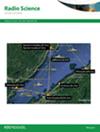High performance antenna system in MIMO configuration for 5G wireless communications over sub-6 GHz spectrum
IF 1.6
4区 地球科学
Q3 ASTRONOMY & ASTROPHYSICS
引用次数: 0
Abstract
This paper presents a high-performance multiple input and multiple output (MIMO) antenna comprising 2 × 2 configuration of radiating elements that is designed for sub-6 GHz applications. The proposed MIMO antenna employs four identical radiating elements. High isolation between the radiating elements and therefore reduced mutual coupling is achieved by spatially arranging the radiating elements in an orthogonal configuration. Also, a novel frequency selective surface (FSS) was employed to increase the gain of the MIMO antenna over a wide bandwidth from 3 to 6 GHz. This was achieved by locating the FSS above the antenna at a certain height. The FSS essentially enhanced the antenna's directivity, reduced back lobe radiation and mutual coupling. The antenna was fabricated on a standard Rogers RT Duroid 5880 dielectric substrate with a 0.8 mm thickness. The overall dimension of the MIMO antenna is 50 × 50 × 12.5 mm 3 and it operates from 3.8 to 6 GHz, which corresponds to a fractional bandwidth of 41%. The proposed MIMO antenna has a measured peak gain of 4.8 dBi and inter radiation element isolation >20 dB. Its envelope correlation coefficient is <0.1>9.9 (dB). These characteristics make the proposed MIMO antenna system suitable for 5G communication systems.用于亚6GHz频谱5G无线通信的MIMO配置的高性能天线系统
本文提出了一种高性能多输入多输出(MIMO)天线,该天线包括2×2配置的辐射元件,专为低于6GHz的应用而设计。所提出的MIMO天线采用四个相同的辐射元件。通过以正交配置在空间上布置辐射元件,实现了辐射元件之间的高度隔离,并因此减少了相互耦合。此外,采用了一种新的频率选择表面(FSS)来在从3到6GHz的宽带宽上增加MIMO天线的增益。这是通过将FSS定位在天线上方某一高度来实现的。FSS基本上增强了天线的指向性,减少了后瓣辐射和相互耦合。该天线是在具有0.8mm厚度的标准Rogers RT Duroid 5880电介质衬底上制造的。MIMO天线的总体尺寸为50×50×12.5mm3,工作频率为3.8至6GHz,相当于41%的分数带宽。所提出的MIMO天线具有4.8dBi的测量峰值增益和>20dB的辐射元件间隔离。其包络相关系数为9.9(dB)。这些特性使得所提出的MIMO天线系统适用于5G通信系统。
本文章由计算机程序翻译,如有差异,请以英文原文为准。
求助全文
约1分钟内获得全文
求助全文
来源期刊

Radio Science
工程技术-地球化学与地球物理
CiteScore
3.30
自引率
12.50%
发文量
112
审稿时长
1 months
期刊介绍:
Radio Science (RDS) publishes original scientific contributions on radio-frequency electromagnetic-propagation and its applications. Contributions covering measurement, modelling, prediction and forecasting techniques pertinent to fields and waves - including antennas, signals and systems, the terrestrial and space environment and radio propagation problems in radio astronomy - are welcome. Contributions may address propagation through, interaction with, and remote sensing of structures, geophysical media, plasmas, and materials, as well as the application of radio frequency electromagnetic techniques to remote sensing of the Earth and other bodies in the solar system.
 求助内容:
求助内容: 应助结果提醒方式:
应助结果提醒方式:


